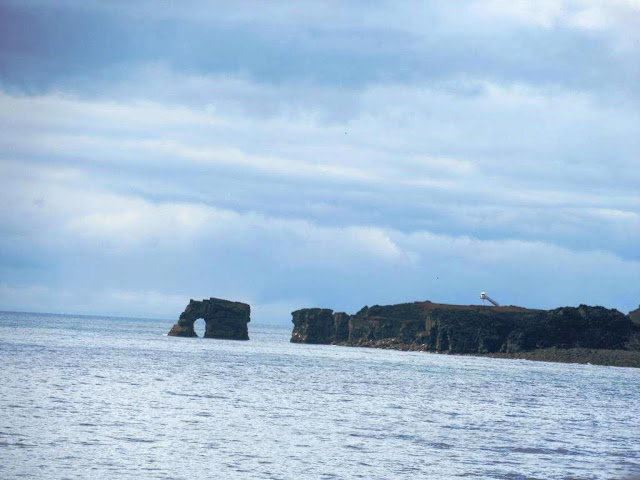The name of the islands, Vestmannaeyjar or Westman Islands, originates from the time when the Irish slaves of Hjörleifur Hróðmarsson who farmed on the south coast, fled to the islands after killing their master at Hjörleifshöfða. Hjörleifur’s foster brother, Ingólfur Arnarson, found where the slaves had landed in Vestmannaeyjar and that place still bears the name of Slave Isthmus. To avenge the murder of his brother, Ingólfur hunted down all the slaves and killed them. Locations in Vestmannaeyjar still bear the names from that event, such as Dufþekja on Heimaklettur, the large bluff at the north of the harbor where Dufþakur, the leader of the slaves, is said to have thrown himself from the cliffs in order to avoid being caught by Ingólfur. To the first Icelanders who came from Norway the Irish were known as “West men,” thus the name, Westman Islands, after the Irish slaves who were killed there.
The largest island of the Westman Islands is Heimaey which has a population around 4200, most of whom live in the archipelago's main town, Vestmannaeyjabær.
There are 15 islands in the chain.
The other islands are uninhabited, although six have single hunting cabins. This is one of the islands hunting cabins!
We were able to see Surtsey, the newest of the Westman Islands which formed from a volcanic eruption lasting from 1963-1967! Surtsey is the small island on the right in the picture below.
We booked a 2-hour puffin/volcano tour with Eyjatours. Our guide, Ebbi, did a great job explaining the history of the island and showing us the highlights of the island. We had 17 people total in our tour, and everyone was attentive. He told us his family dates back to 900AD living on the island, so he is an “Island Boy.” Fishing is the main industry and the island provides 15% of all the fish in Iceland.
We went to a hill which is supposed to be the windiest place in all of Europe. Luckily, for us, the weather wasn’t too bad and neither was the wind! We went out to a cliff to spot puffins landing and taking off. They have the craziest way of flying with their little stubby wings. There were many floating in the water and fishing.

We could also see Eider ducks in the water.
Our tour took us to the base of the Eldfell volcano. 
In 1973, the eruption of Eldfell volcano just outside of Vestmannaeyjar destroyed many buildings and forced a five month long evacuation of the entire population to mainland Iceland. Approximately one fifth of the town was destroyed before the lava flow was halted by application of 6.8 billion liters of cold sea water. The size of the island increased between 20-30% from that eruption!
Our last stop on the tour was the Puffin and Beluga sanctuary where we actually got to have our picture taken with a puffin that had been rescued. They had some strange looking fish on display, too!
We stopped for lunch then walked back to see the Danish Stave Church and the Midwife/Doctors Office Museum.
It was a good day and didn’t really rain until lunchtime! We caught the 5pm ferry back to the mainland and continued with more sightseeing!
We drove past the Eyjafjallajökull Glacier. Eyjafjallajökull is one of the smaller ice caps of Iceland, north of Skógar and west of Mýrdalsjökull. The ice cap covers the caldera of a volcano with a summit elevation of 1,651 meters. The volcano erupted most recently in 2010.
We also saw the beautiful Eyjafjöll mountains where several manmade caves can be found. We stopped at the Rútshellir cave. The cave is located in a peculiar, big tuff pillar of rock. There are some structures in front of the cave including an old sheepcote, first built in around 1917, so it looks like somebody lives in the rock.
We went on to Skógafoss, one of the biggest waterfalls in Iceland. It has a a drop of about 200 feet and a width of 80 feet. You could walk up to it, but we chose not to get drenched!
Next stop was Sólheimajökull glacier tongue, or outlet glacier of Mýrdalsjökull, the 4th largest glacier in Iceland. We hiked about one half mile to see the tongue where it melts into a river.
We did see a group of hikers on the glacier, but that is not something I want to try!
We made it back to the South Island Guesthouse in Steiner about 8pm. We shared a cozy room for the night! Needless to say, even though Wendy and I booked our room over a year ago, there weren’t many choices in this area!
Tomorrow we have another busy day scheduled!


























No comments:
Post a Comment